Maps and Books
The deeper you are in the backcountry the more knowledge you need about the area, terrain, and local plants and animals.
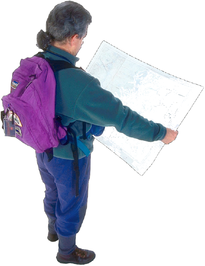
Here's the type of maps and books that we like for camping and why we like them:
- Local Hiking Information
- Local Camping and Campsite Information
- Local Area Maps
- State/Regional Camping and Campsite Information
- State/Regional Area Maps
- Animal Identification
- Bird Identification
- Plant Identification
- Local and Regional Edible Wild Food Information
- Local Medicinal Plant Information
- Survival Skill and Reference Books
- Note: click on any photo to enlarge it
- Note: click on any photo to enlarge it
Local Hiking Information
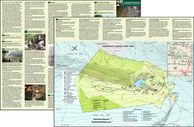
We are firm believers that “knowledge is power”, so the more that you know about where you are planning to hike and camp the better. Like other areas when we get maps and books we use a “tiered” system. In this case our tiers are based on locating the relevant trail information for the specific location that we are planning to visit and then radiating out from there in distance and type of information. Based on this approach the first tier of information that we gather is the information related to the specific hiking area. This includes: 1) a trail map, 2) opening and closing hours (if appropriate), 3) local sights, 4) local activities, 5) local wildlife, 6) fire policies/restrictions, and 7) other pertinent information. Although you can sometimes obtain this information when you arrive at the local area, we find that getting it before you ever leave home allows you to plan a much better adventure. You can get maps like this at your local trail, download them from the trail’s website, or you can sometimes buy them at your local outdoor store or Amazon; depending on the hiking location.
Local Camping and Campsite Information
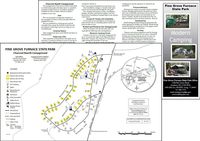
The local camping and campsite information is the second level of information that we normally obtain. Since it is often separate from the hiking information you should check to make sure that you have all the necessary information when you get any brochures/maps. The camping information normally includes the same type of information that the hiking brochures do, with the following additions: 1) number of campsites, 2) services at the campsites, 3) need for campsite reservations, 4) maximum camping duration, 5) maximum number of people at a campsite, 6) pet policies and 7) other specific overnight related policies. You can get maps like this at your local trail, download them from the trail’s website, or you can sometimes buy them at your local outdoor store or Amazon, depending on the camping location.
Local Area Maps
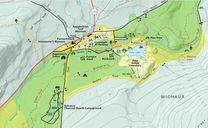
After we have the details on the specific local hiking trails and campsites we normally look for maps on the broader local area since many times we end up on a trail that leaves the marked local hiking area and heads into a different area. Having a trail map that ends when the trail continues can be frustrating, and sometimes dangerous. You can get maps like this at your local trail, download them from the trail’s website, or you can buy them at Amazon or your local outdoor store, or you can buy an offline map app at the Apple App Store or Google Play store.
State/Regional Camping and Campsite Information
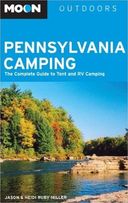
Since we sometimes hike/camp for a couple of days in one local area and then drive to another local area the next level of information that we obtain is hiking/camping information on the entire State or region. That way we can plan ahead and hit a couple of areas that offer different experiences all on the same trip. One great example of this is hiking/camping along the Appalachian Trail. You might not want to commit to the entire 2,200 mile trail, but you might want to hike parts of it in several different states to see the breadth of the Appalachian Mountain range. You can buy regional campsite books like this at Amazon.
State/Regional Area Maps
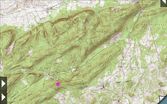
Topo Maps by Phil Endecott.
If you choose to hike in several areas, or over a long distance, then in addition to the State/Regional information you will need to obtain State/Regional maps. Since we have ventured to lots of areas our choice for State/Regional level maps is to use an app that has the capability to download the detailed USGS topological maps for whatever location we want to head to. Our preferred offline map app is “Topo Maps” by Phil Endecott. You can get this app at the Apple App Store and similar apps at the Google Play store.
If you choose to hike in several areas, or over a long distance, then in addition to the State/Regional information you will need to obtain State/Regional maps. Since we have ventured to lots of areas our choice for State/Regional level maps is to use an app that has the capability to download the detailed USGS topological maps for whatever location we want to head to. Our preferred offline map app is “Topo Maps” by Phil Endecott. You can get this app at the Apple App Store and similar apps at the Google Play store.
Animal Identification
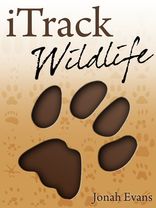
iTrack Wildlife Pro by Jonah Evans
Once you have found all of the relevant information to sort out all the travel and overnight location details of your trip you might want to get the information sources that can help you identify the animals you might either run into or see signs of while you are in the Backcountry. For this purpose we like the “iTrack Wildlife Pro” app by Jonah Evans. This app has detailed photos and information for 70 common mammals of North America, to include over 700 high quality track, sign, and animal photos with detailed captions. It also stores the Wikipedia page for each species in the app so that no internet connection is required for even more details. You can buy this app at the Apple App Store or Google Play store.
Once you have found all of the relevant information to sort out all the travel and overnight location details of your trip you might want to get the information sources that can help you identify the animals you might either run into or see signs of while you are in the Backcountry. For this purpose we like the “iTrack Wildlife Pro” app by Jonah Evans. This app has detailed photos and information for 70 common mammals of North America, to include over 700 high quality track, sign, and animal photos with detailed captions. It also stores the Wikipedia page for each species in the app so that no internet connection is required for even more details. You can buy this app at the Apple App Store or Google Play store.
Bird Identification
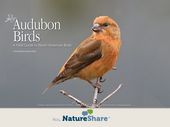
Audubon Bird Guide: North America by National Audubon Society (offline)
Naturetouch Identify 500 Birds by Coogni GmbH (online)
In addition to identifying animals we spend time trying to identify birds as we hike and camp. To do this we use two apps. “Audubon Bird Guide: North America” by National Audubon Society (offline) and “Naturetouch Identify 500 Birds” by Coogni GmbH (online). The Audubon app includes 821 species with in-depth descriptions including information on appearance, habitat, behavior and sounds. The app includes over 3,200 images. The Naturetouch app takes a totally different approach and allows you to identify 500 birds and 934 plumages in a step by step process that focuses on each individual part of the bird’s appearance (e.g. beak, head, wings, chest, coloration, etc.,). The app will help you identify the formal name of the bird offline – but the goes to Google images to allow you to see other photos of the bird to confirm your identification. We find that even without an online connection we can use this app to help identify a bird that we can then look up in out Audubon app. You can buy these apps at the Apple App Store or Google Play store.
Naturetouch Identify 500 Birds by Coogni GmbH (online)
In addition to identifying animals we spend time trying to identify birds as we hike and camp. To do this we use two apps. “Audubon Bird Guide: North America” by National Audubon Society (offline) and “Naturetouch Identify 500 Birds” by Coogni GmbH (online). The Audubon app includes 821 species with in-depth descriptions including information on appearance, habitat, behavior and sounds. The app includes over 3,200 images. The Naturetouch app takes a totally different approach and allows you to identify 500 birds and 934 plumages in a step by step process that focuses on each individual part of the bird’s appearance (e.g. beak, head, wings, chest, coloration, etc.,). The app will help you identify the formal name of the bird offline – but the goes to Google images to allow you to see other photos of the bird to confirm your identification. We find that even without an online connection we can use this app to help identify a bird that we can then look up in out Audubon app. You can buy these apps at the Apple App Store or Google Play store.
Plant Identification

Naturetouch Identify 3000 Plants by Coogni GmbH (online)
Identifying plants, both helpful and harmful, in the backcountry becomes more important the longer you are out there and the further from civilization that you get. To help us identify plants we use the “Naturetouch Identify 3000 Plants” by Coogni GmbH (online). Like the Naturetouch bird identification app this plan identification app focuses on different parts of the plant (leaves, stem, flower, etc.,) and leads you through a process to help identify the plant from its parts. Although you need an online connection to go from the formal name to the Google images page, we still find this helpful; more so we have an internet connection. This app is new so we hope the amount of offline detail will be increased. You can buy this app at the Apple App Store or Google Play store.
Identifying plants, both helpful and harmful, in the backcountry becomes more important the longer you are out there and the further from civilization that you get. To help us identify plants we use the “Naturetouch Identify 3000 Plants” by Coogni GmbH (online). Like the Naturetouch bird identification app this plan identification app focuses on different parts of the plant (leaves, stem, flower, etc.,) and leads you through a process to help identify the plant from its parts. Although you need an online connection to go from the formal name to the Google images page, we still find this helpful; more so we have an internet connection. This app is new so we hope the amount of offline detail will be increased. You can buy this app at the Apple App Store or Google Play store.
Local and Regional Edible Wild Food Information

If you want to know about which edible plants in the area that you are hiking and camping in then you need to find a book appropriate to that region. You can buy edible wild food books like this at Amazon.
Local and Regional Medicinal Plant Information
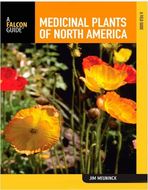
Medicinal Plants of North America: A Field Guide (Falcon Guide)
If you are interested in knowing about the medicinal plants in the area that you are hiking and camping in then you need to find a book appropriate to that region. We like “Medicinal Plants of North America: A Field Guide” because this one book covers all of the plants of North America and it splits them out by environmental regions. You can buy this medicinal plants book at Amazon.
If you are interested in knowing about the medicinal plants in the area that you are hiking and camping in then you need to find a book appropriate to that region. We like “Medicinal Plants of North America: A Field Guide” because this one book covers all of the plants of North America and it splits them out by environmental regions. You can buy this medicinal plants book at Amazon.
Survival Skill and Reference Books
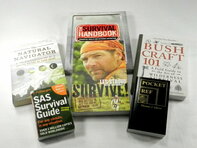
Like most people that spend time in the outdoors we have accumulated a few good books filled with great information over the years. If you ask you friends, or search the internet, for recommendations about which Hiking, Camping or Survival books you should have in your home library I’m sure that you’ll come up with a vast array of references. Actually - probably too many. So how do you separate the good ones from the bad?
Although there can be overlap between the types, in our opinion, the knowledge that you need for the outback is contained in three categories of books:
1) Visual and skill reference books
2) Mindset and attitude books
3) Pure reference books
We have a couple of each type. Based on our experience the “go to” books that we keep with our gear so that we can easily find and reference them are:
1) The Survival Handbook: Essential Skills for Outdoor Adventure by DK Publishing and Colin Towell
2) Survive!: Essential Skills and Tactics to Get You Out of Anywhere – Alive by Les Stroud
3) SAS Survival Guide 2E (Collins Gem): For any climate, for any situation by John "Lofty" Wiseman
4) Bushcraft 101: A Field Guide to the Art of Wilderness Survival by Dave Canterbury
5) The Natural Navigator: The Rediscovered Art of Letting Nature Be Your Guide by Tristan Gooley
6) Pocket Ref 4th Edition by Thomas Glover
Here’s a little about each book and why we like it:
Although there can be overlap between the types, in our opinion, the knowledge that you need for the outback is contained in three categories of books:
1) Visual and skill reference books
2) Mindset and attitude books
3) Pure reference books
We have a couple of each type. Based on our experience the “go to” books that we keep with our gear so that we can easily find and reference them are:
1) The Survival Handbook: Essential Skills for Outdoor Adventure by DK Publishing and Colin Towell
2) Survive!: Essential Skills and Tactics to Get You Out of Anywhere – Alive by Les Stroud
3) SAS Survival Guide 2E (Collins Gem): For any climate, for any situation by John "Lofty" Wiseman
4) Bushcraft 101: A Field Guide to the Art of Wilderness Survival by Dave Canterbury
5) The Natural Navigator: The Rediscovered Art of Letting Nature Be Your Guide by Tristan Gooley
6) Pocket Ref 4th Edition by Thomas Glover
Here’s a little about each book and why we like it:
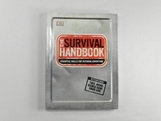
The Survival Handbook: Essential Skills for Outdoor Adventure - by DK Publishing and Colin Towell
Over the years we’ve looked at and read a lot of survival/bushcraft books. Unfortunately we’ve found that many of them are so dense with text that it is hard to assimilate and retain the information that they are attempting to impart. So, if you are looking for a great book on survival situations and techniques that has lots of illustrations, “What to Do” decision trees and detailed step-by-step instructions, you should buy this book.
In our opinion the book strikes a great balance between the information that you need and showing what it means and how to do it. The book is laid out logically and the illustrations are plentiful and concise. Measuring 7½ x 1 x 10 inches and weighing ~2 pounds this 320 page book the book is probably too big to take in your backpack – but is certainly the right size to put in your car or to study at home before you hit the trails.
The book has sections on:
We really like all the detailed illustrations in this book. They are what set it apart from so many other books on the market. You can buy this book at Amazon (ISBN-13: 978-0756690380).
Over the years we’ve looked at and read a lot of survival/bushcraft books. Unfortunately we’ve found that many of them are so dense with text that it is hard to assimilate and retain the information that they are attempting to impart. So, if you are looking for a great book on survival situations and techniques that has lots of illustrations, “What to Do” decision trees and detailed step-by-step instructions, you should buy this book.
In our opinion the book strikes a great balance between the information that you need and showing what it means and how to do it. The book is laid out logically and the illustrations are plentiful and concise. Measuring 7½ x 1 x 10 inches and weighing ~2 pounds this 320 page book the book is probably too big to take in your backpack – but is certainly the right size to put in your car or to study at home before you hit the trails.
The book has sections on:
- Before You Go
- On The Trail
- Camp Craft
- Taking Shelter
- Water and Food
- In An Emergency
- First Aid
- Appendices on Wild Food and Natural Dangers
We really like all the detailed illustrations in this book. They are what set it apart from so many other books on the market. You can buy this book at Amazon (ISBN-13: 978-0756690380).
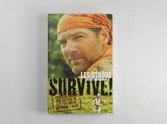
Survive!: Essential Skills and Tactics to Get You Out of Anywhere – Alive - by Les Stroud
Many books focus on the specific skills that you need to hike/camp and/or survive in the outback, but these skills are just one part of what you need. In our opinion you need five things to safely travel through the outback on a routine trip:
1) the right physical conditioning – to make sure you can endure the outdoor activities
2) the right planning and preparation – to make sure you know what you are getting into
3) the right gear – to make sure you have the proper gear for the season, weather, environment
4) the right knowledge – to make sure you understand how to do what you need to do
5) the right skills - since academically knowing how to use a bow drill does not mean that you can actually start a fire with one in the wild if you have never even tried it before
To make it through a survival situation you need these five things plus two more:
6) the right mental attitude – the will to live and get through whatever is thrown at you
7) luck – something that you cannot control
That’s where Les Stroud’s book comes in. This is an outdoor “survival” book – not just a bush craft book - like so many other books on the market. It is specifically focused on the skills and mental attitude that you need to get yourself out of an unexpected survival situation. Consequently, the book is laid out in a very linear fashion - focusing on the order that you should follow to prepare for and to survive an unanticipated emergency situation. This also leads to the largest difference between Les Stroud’s book and many others – his book is focused on getting out of the back country alive and as quickly as possible – not how to live off the grid in the wilderness as a way of life. Although many of the skills between these two activities are similar (or the same), the end goal of using them (and where/how you expend your energy) is significantly different.
The book has sections on:
One thing that we really like is - because of Les Stroud’s “Survivorman” TV show (7 seasons – 57 1-hour episodes as of December 2015) you can not only read this book but you can actually see Les put his skills to use in a wide variety of situations and environments around the world. This gives you a chance to really get a detailed feel for what the book covers. The book has 373 pages, measures 5½ x 1 x 8½ inches and weighs 1 pound. You can buy this book at Amazon (ISBN-13: 978-0061373510),
Many books focus on the specific skills that you need to hike/camp and/or survive in the outback, but these skills are just one part of what you need. In our opinion you need five things to safely travel through the outback on a routine trip:
1) the right physical conditioning – to make sure you can endure the outdoor activities
2) the right planning and preparation – to make sure you know what you are getting into
3) the right gear – to make sure you have the proper gear for the season, weather, environment
4) the right knowledge – to make sure you understand how to do what you need to do
5) the right skills - since academically knowing how to use a bow drill does not mean that you can actually start a fire with one in the wild if you have never even tried it before
To make it through a survival situation you need these five things plus two more:
6) the right mental attitude – the will to live and get through whatever is thrown at you
7) luck – something that you cannot control
That’s where Les Stroud’s book comes in. This is an outdoor “survival” book – not just a bush craft book - like so many other books on the market. It is specifically focused on the skills and mental attitude that you need to get yourself out of an unexpected survival situation. Consequently, the book is laid out in a very linear fashion - focusing on the order that you should follow to prepare for and to survive an unanticipated emergency situation. This also leads to the largest difference between Les Stroud’s book and many others – his book is focused on getting out of the back country alive and as quickly as possible – not how to live off the grid in the wilderness as a way of life. Although many of the skills between these two activities are similar (or the same), the end goal of using them (and where/how you expend your energy) is significantly different.
The book has sections on:
- Trip Planning and Preparation
- Survival Kits
- Psychological Aspects of Survival
- Signaling
- Water
- Fire
- Shelter
- Food
- Survival Travel and Navigation
- Dangers and Hazards
- Weather
- Clothing
- Survival First Aid
- Essential Survival Skills
- When Disaster Strikes Close to Home
- Checklists
- Personal Survival Kit Checklist
- Complete Survival Kit Checklist
- Vehicle Survival Kit Checklist
- First Aid Kit Checklist
- Home Survival Kit Checklist
One thing that we really like is - because of Les Stroud’s “Survivorman” TV show (7 seasons – 57 1-hour episodes as of December 2015) you can not only read this book but you can actually see Les put his skills to use in a wide variety of situations and environments around the world. This gives you a chance to really get a detailed feel for what the book covers. The book has 373 pages, measures 5½ x 1 x 8½ inches and weighs 1 pound. You can buy this book at Amazon (ISBN-13: 978-0061373510),
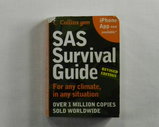
SAS Survival Guide 2E (Collins Gem): For any climate, for any situation - by John "Lofty" Wiseman
If you’ve been reading books on Survival for very long you are sure to have come across John "Lofty" Wiseman's “SAS Survival Handbook, The Ultimate Guide to Surviving Anywhere: Third Edition (William Morrow Paperbacks)”. This book is a favorite of many people.
Although we like the “SAS Survival Handbook” we actually have found another book by Wiseman to be a better reference source for our purposes; the “SAS Survival Guide For any climate, for any situation: 2nd Edition (Collins Gem)”. Even though this book is only 384 pages long, we prefer it because it is actually a book that we can take with us into the outback since it measures only 3¼ x 1 x 4 5/8 inches and only weighs 7 ounces. The more common “SAS Survival Handbook” has 672 pages, measures 5¼ x 1 1/8 x 8¼ inches and weighs almost 2 pounds. So, although the smaller “SAS Survival Guide” only has 57% of the number of pages (and a lot smaller print), we have found it more useful since we can carry it with us when we need it.
The book has sections on:
Unfortunately, the pocket sized “SAS Survival Guide“ was last printed in 2010 so it is becoming harder to find – especially at a rational price. Since each book contains information that the other doesn't you might consider buying both – the small one for active use on the trail and the larger one for research at home. You can buy this book (probably used) at Amazon (ISBN-13: 978-0061992865). There is also an electronic version of the “SAS Survival Guide” (by Trellisys.net) available for both iPhone/iPad and Android devices.
If you’ve been reading books on Survival for very long you are sure to have come across John "Lofty" Wiseman's “SAS Survival Handbook, The Ultimate Guide to Surviving Anywhere: Third Edition (William Morrow Paperbacks)”. This book is a favorite of many people.
Although we like the “SAS Survival Handbook” we actually have found another book by Wiseman to be a better reference source for our purposes; the “SAS Survival Guide For any climate, for any situation: 2nd Edition (Collins Gem)”. Even though this book is only 384 pages long, we prefer it because it is actually a book that we can take with us into the outback since it measures only 3¼ x 1 x 4 5/8 inches and only weighs 7 ounces. The more common “SAS Survival Handbook” has 672 pages, measures 5¼ x 1 1/8 x 8¼ inches and weighs almost 2 pounds. So, although the smaller “SAS Survival Guide” only has 57% of the number of pages (and a lot smaller print), we have found it more useful since we can carry it with us when we need it.
The book has sections on:
- Essentials
- Climate and Terrain
- Food
- Camp Craft
- Reading the Signs
- On the Move
- Survival at Sea
- Rescue
- Health
- Disaster Strategies
Unfortunately, the pocket sized “SAS Survival Guide“ was last printed in 2010 so it is becoming harder to find – especially at a rational price. Since each book contains information that the other doesn't you might consider buying both – the small one for active use on the trail and the larger one for research at home. You can buy this book (probably used) at Amazon (ISBN-13: 978-0061992865). There is also an electronic version of the “SAS Survival Guide” (by Trellisys.net) available for both iPhone/iPad and Android devices.
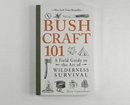
Bushcraft 101: A Field Guide to the Art of Wilderness Survival - by Dave Canterbury
Most books about survival and outdoor skills don’t become “bestsellers”. But somehow Bushcraft 101 made it onto the 2014 New York Times list of Best Selling Sports Books. Why was that? In our opinion this book was popular because it’s a good, basic beginner bushcraft/wilderness survival book that can also be enjoyed by an experienced outdoors person because of the author’s credentials, writing style and content.
Written by Dave Canterbury, known to many people as one of the original two survivalists on the TV show “Dual Survival,” where he was teamed with Cody Lundin (Dave was the one that wore shoes), the book focuses on Dave’s view of bushcraft; a view that means taking advantage of what nature makes available to you and using a minimum of gear to survive and thrive in the natural world, carrying “the knowledge and skills needed to create items straight from the landscape”.
The main way that Dave’s book differs from the first two books on our favorites list is due to his focus on the skills necessary to thrive in the woods – not just the skills essential to surviving in the wild in an emergency. Because of this much of the book is based on Canterbury’s “Five Cs of Survivability” – items chosen since they are extremely hard to make in the wild and directly impact controlling your body’s core temperature. Dave’s Five Cs are:
1) Cutting Tools – to manufacture needed items and process food
2) Covering Elements – to create a microclimate of protection from the elements
3) Combustion Devices – for creating the fires needed not only to preserve and cook food, but also to make medicines and provide needed warmth
4) Containers – to carry water over distances or to protect collected food sources
5) Cordages – for bindings and lashings
The book also shows how Dave has a “systems” mindset (e.g. never carry anything unless it can perform multiple functions).
The book has sections on:
Dave’s detailed section on Tools is especially helpful for people new to camping. We also like Dave’s “Four Ws” relating to setting up a camp – Wood, Water, Wind and Widowmakers. Having 256 pages, measuring 5½ x ¾ x 8½ inches and weighing ~10 ounces this is probably a book that you learn from but do not take on the trail with you. Although shorter than all of our other recommended books, Bushcraft 101 is not intended to be all encompassing – since it is only intended to cover the “20 percent of bushcraft that is of the most value”. You can buy this book at Amazon (ISBN-13: 978-1440579776).
Most books about survival and outdoor skills don’t become “bestsellers”. But somehow Bushcraft 101 made it onto the 2014 New York Times list of Best Selling Sports Books. Why was that? In our opinion this book was popular because it’s a good, basic beginner bushcraft/wilderness survival book that can also be enjoyed by an experienced outdoors person because of the author’s credentials, writing style and content.
Written by Dave Canterbury, known to many people as one of the original two survivalists on the TV show “Dual Survival,” where he was teamed with Cody Lundin (Dave was the one that wore shoes), the book focuses on Dave’s view of bushcraft; a view that means taking advantage of what nature makes available to you and using a minimum of gear to survive and thrive in the natural world, carrying “the knowledge and skills needed to create items straight from the landscape”.
The main way that Dave’s book differs from the first two books on our favorites list is due to his focus on the skills necessary to thrive in the woods – not just the skills essential to surviving in the wild in an emergency. Because of this much of the book is based on Canterbury’s “Five Cs of Survivability” – items chosen since they are extremely hard to make in the wild and directly impact controlling your body’s core temperature. Dave’s Five Cs are:
1) Cutting Tools – to manufacture needed items and process food
2) Covering Elements – to create a microclimate of protection from the elements
3) Combustion Devices – for creating the fires needed not only to preserve and cook food, but also to make medicines and provide needed warmth
4) Containers – to carry water over distances or to protect collected food sources
5) Cordages – for bindings and lashings
The book also shows how Dave has a “systems” mindset (e.g. never carry anything unless it can perform multiple functions).
The book has sections on:
- Gearing Up
- Your Pack
- Tools
- Rope, Cordage, Webbings, and Knots
- Containers and Cooking Tools
- Coverage
- Combustion
- In The Bush
- Setting Up Camp
- Navigating Terrain
- Trees: the Four-Season Resource
- Trapping and Processing Game
- Appendices
- Conserving and Utilizing resources
- Wild Edibles and Medicinal Plants
- Bush Recipes
- Glossary
Dave’s detailed section on Tools is especially helpful for people new to camping. We also like Dave’s “Four Ws” relating to setting up a camp – Wood, Water, Wind and Widowmakers. Having 256 pages, measuring 5½ x ¾ x 8½ inches and weighing ~10 ounces this is probably a book that you learn from but do not take on the trail with you. Although shorter than all of our other recommended books, Bushcraft 101 is not intended to be all encompassing – since it is only intended to cover the “20 percent of bushcraft that is of the most value”. You can buy this book at Amazon (ISBN-13: 978-1440579776).
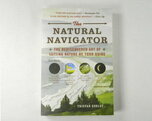
The Natural Navigator: The Rediscovered Art of Letting Nature Be Your Guide - by Tristan Gooley
When we’re in the outback, especially the deep outback, we like to have all the necessary navigation tools that we can (e.g. trail map, compass, GPS app, etc.,) to make sure that we successfully find our way to where we are going. But, in addition to having these tools, you need to have the knowledge related to how to use them, and the basic knowledge of how to read the signs of the wilderness around you.
So, to enhance our backwoods navigation skills, we like Tristan Gooley's "The Natural Navigator". The book has lots of great information on how to navigate in the wild, to include tips on how to use the Sun, moon, stars, sea, plants, animals and weather to help you find your way without many of today’s commonplace navigation aids.
As the title says, Tristan’s approach is to recapture the method that humans used in the past to navigate using Nature instead of tools. This includes techniques for finding directional clues from uncommon topics like a windswept tree, changing tides, plant growth, the habits of wildlife, the depth of a puddle, clouds, weather patterns, and the more common topics of the sun, moon, stars, and lengthening shadows. The book is also full of navigational anecdotes from around the world – and if nothing else will change how you look at, and examine, the world around you when you are in the outback hiking and camping. This book is published by The Experiment, has 307 pages, measures 8¼ x ¾ x 5½ inches and weighs ~10 ounces.
The book has sections on:
The Natural Navigator is a little different than the other Survival Skill and Reference Books on our list since it is less “survival task” focused and more philosophical in nature due to its approach and writing style. You can buy this book at Amazon (ISBN-13: 978-1615190461).
When we’re in the outback, especially the deep outback, we like to have all the necessary navigation tools that we can (e.g. trail map, compass, GPS app, etc.,) to make sure that we successfully find our way to where we are going. But, in addition to having these tools, you need to have the knowledge related to how to use them, and the basic knowledge of how to read the signs of the wilderness around you.
So, to enhance our backwoods navigation skills, we like Tristan Gooley's "The Natural Navigator". The book has lots of great information on how to navigate in the wild, to include tips on how to use the Sun, moon, stars, sea, plants, animals and weather to help you find your way without many of today’s commonplace navigation aids.
As the title says, Tristan’s approach is to recapture the method that humans used in the past to navigate using Nature instead of tools. This includes techniques for finding directional clues from uncommon topics like a windswept tree, changing tides, plant growth, the habits of wildlife, the depth of a puddle, clouds, weather patterns, and the more common topics of the sun, moon, stars, and lengthening shadows. The book is also full of navigational anecdotes from around the world – and if nothing else will change how you look at, and examine, the world around you when you are in the outback hiking and camping. This book is published by The Experiment, has 307 pages, measures 8¼ x ¾ x 5½ inches and weighs ~10 ounces.
The book has sections on:
- Introduction: The Art of Natural Navigation
- Awakening the Senses
- Vale and Dune: The Land
- The Perfect Illusion: The Sun
- The Firmament
- The Fickle Moon
- The Sea
- The Elements
- Creatures of Habit
- Where Am I?
- Unity: An Epilogue
The Natural Navigator is a little different than the other Survival Skill and Reference Books on our list since it is less “survival task” focused and more philosophical in nature due to its approach and writing style. You can buy this book at Amazon (ISBN-13: 978-1615190461).

Pocket Ref 4th Edition – by Thomas Glover
If you’ve ever watched the MythBusters TV show you probably saw them pick up and refer to a small black reference book every once in a while. Well this book is the “Pocket Ref”, and it has a wealth of information that can come in handy in all sorts of situations. The book by Sequoia Publishing has 864 pages, measures 3¼ x 1 x 5½ inches and weighs 7 ounces.
The book has sections on:
- Air and Gasses
- Automotive
- Carpentry and Construction
- Chemistry and Physics
- Computers
- Constants – Physical, Chemical and Math
- Electrical – Wire, Motors, Frames, Receptacles
- Electronics
- Fasteners – Bolts and Threads, Nails, Screws
- First Aid
- General Information 1 (Holidays, Seasons, Birthstones, Phonetic Alphabet, Military Ranks, Bed Sizes, Climate Data in US Cities, Time Zones, and many other topics)
- General Information 2 (Telephone Numbers & Airports)
- General Science
- Geology
- Glue, Solvents, Paints and Finishes
- Math
- Mine, Mill and Aggregate
- Money
- Pipe and Fittings
- Pumps and Tanks
- Rope, Cable, Chain and Knots
- Steel and Metals
- Surveying and Mapping
- Tools
- Water
- Weather and Weather Safety
- Weights and Properties of Materials
- Welding
- Conversion Tables
- 14 Year Perpetual Calendar
Although this reference book may seem like an odd book to have for survival, much of the information in the book is invaluable if you need to build or fix something on your own – without an expert to help you. You can buy this book at Amazon (ISBN-13: 978-1885071620). If you want even more reference information there’s a 1,280 pages “DeskRef” too – but measuring 6 x 1 3/8 x 9 inches, and weighing 2 pounds, it’s a little big to take with you in the outback. Buy this book! You won’t regret it!